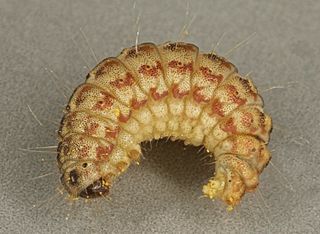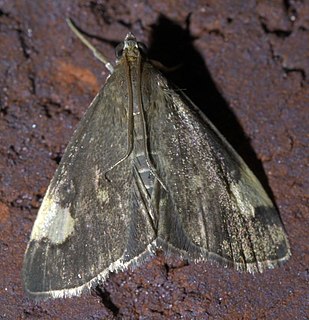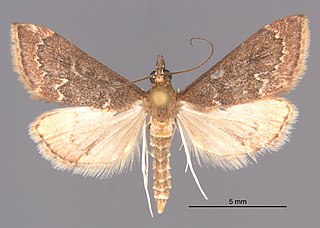
The Crambidae are the grass moth family of lepidopterans. They are variable in appearance, the nominal subfamily Crambinae taking up closely folded postures on grass stems where they are inconspicuous, while other subfamilies include brightly coloured and patterned insects which rest in wing-spread attitudes.

The Pyralidae, commonly called pyralid moths, snout moths or grass moths, are a family of Lepidoptera in the ditrysian superfamily Pyraloidea. In many classifications, the grass moths (Crambidae) are included in the Pyralidae as a subfamily, making the combined group one of the largest families in the Lepidoptera. The latest review by Eugene G. Munroe and Maria Alma Solis retain the Crambidae as a full family of Pyraloidea.

The Pyraloidea are a moth superfamily containing about 16,000 described species worldwide, and probably at least as many more remain to be described. They are generally fairly small moths, and as such, they have been traditionally associated with the paraphyletic Microlepidoptera.
Paracorsia is a monotypic moth genus of the family Crambidae described by H. Marion in 1959. It contains only one species, Paracorsia repandalis, described by Michael Denis and Ignaz Schiffermüller in 1775. It is found in most of Europe, except Ireland, Fennoscandia and the Baltic region. It has also been recorded from central Asia, including Iran and Kyrgyzstan and North America where it has been recorded in southern Ontario and northern Indiana.

Sclerocona is a genus of moths of the family Crambidae which contains only one species, Sclerocona acutella. It was first described by the Prussian biologist Eduard Friedrich Eversmann in 1842.

Pyralis regalis is a species of snout moth. It is found from most of Europe east to Asia, including China, Cambodia, Myanmar, India, Russia, Korea, Japan and Taiwan.

Phycitodes saxicola, the small clouded knot-horn, is a species of snout moth described by Vaughan in 1870. It is found in most of Europe, as well as Iran, Morocco and the Canary Islands.
Phycita poteriella is a species of snout moth. It is found in North Macedonia, Greece, Bulgaria, Romania, Croatia, Italy and Spain. It has also been recorded from Israel and Yemen.
Eoophyla citrialis is a moth in the family Crambidae. It was described by David John Lawrence Agassiz in 2012. It is found in Tanzania, where it has been recorded from the Eastern Arc Mountains.
Parapoynx epimochla is a moth in the family Crambidae. It was described by Turner in 1908. It is found in Australia, where it has been recorded from New South Wales.
Neoeromene parvipuncta is a moth in the family Crambidae. It was described by David E. Gaskin in 1986. It is found in Paraná, Brazil.

Evergestis unimacula, the large-spotted evergestis moth, is a moth in the family Crambidae. It was described by Augustus Radcliffe Grote and Coleman Townsend Robinson in 1867. It is found in North America, where it has been recorded from Georgia, Illinois, Indiana, Iowa, Maryland, Michigan, North Carolina, Ohio, Oklahoma, Ontario, Pennsylvania, Quebec, Tennessee and West Virginia. Outliers have been recorded from Florida.
Cosmopterosis spatha is a moth in the family Crambidae. It was described by Maria Alma Solis in 2009. It is found in Costa Rica, where it has been recorded from the provinces of Alajuela, Guanacaste, Limon and Puntarenas. It is found at altitudes between 50 and 1,600 meters.

Oenobotys vinotinctalis, the wine-tinted oenobotys moth, is a moth in the family Crambidae. It was described by George Hampson in 1895. It is found in the United States, where it has been recorded from North Carolina to Florida, west to Texas. It is also found in the West Indies and from Mexico to Central America.

Pyrausta roseivestalis is a moth in the family Crambidae. It was described by Eugene G. Munroe in 1976. It is found in North America, where it has been recorded from California and southern Arizona.
Choristostigma particolor is a moth in the family Crambidae. It was described by Harrison Gray Dyar Jr. in 1914. It is found in Zacualpan, Mexico.
Pantographa scripturalis, the Andean leaf-roller, is a moth in the family Crambidae. It was described by Achille Guenée in 1854. It is found from Colombia to Bolivia. The habitat consists of cloud forests, where it has been recorded from altitudes between 800 and 1,800 meters.
Penestola bufalis, the black penestola moth, is a moth in the family Crambidae. It was described by Achille Guenée in 1854. It is found in the US states of Texas and Florida, as well as on the Antilles. It is an accidentally introduced species on the Galápagos Islands. The habitat consists of coastal mangrove swamps and shorelines.
Sufetula carbonalis is a moth species in the family Crambidae. It was described by James E. Hayden in 2013.It is found in North America, where it has been recorded from Florida.








